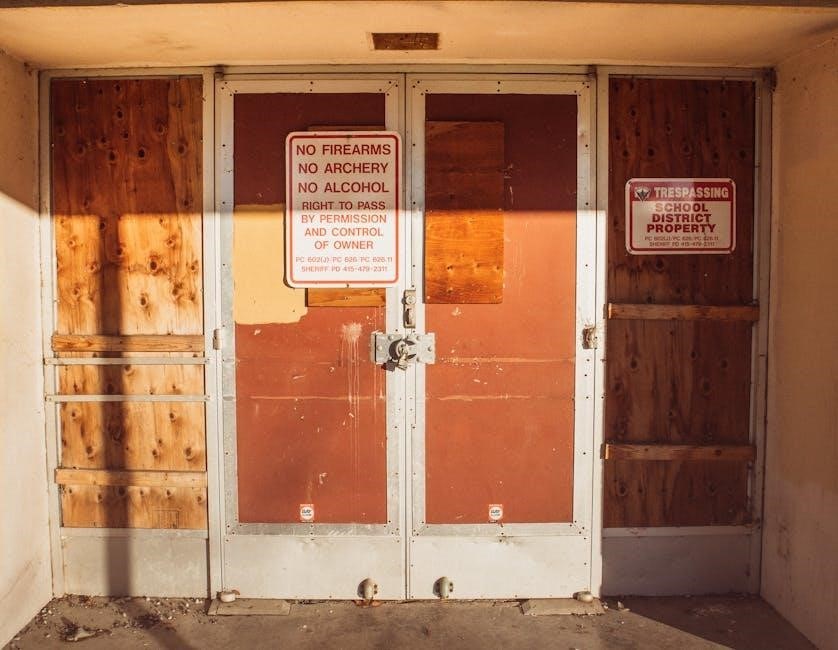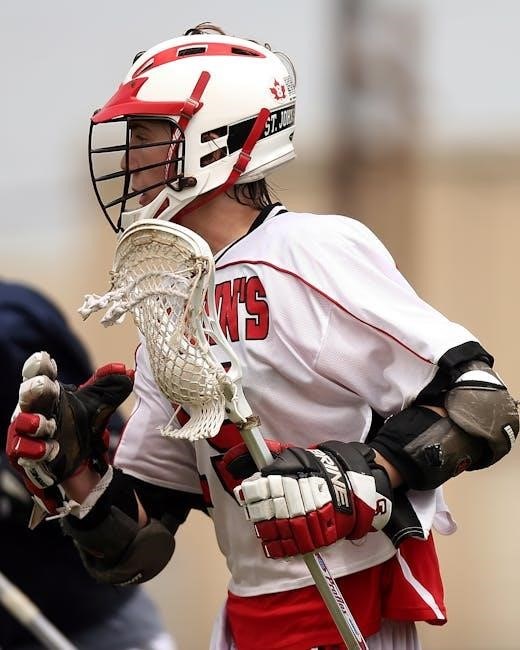Objective and Basic Rules of High School Lacrosse
The objective is to score goals by throwing, carrying, or catching the ball using a lacrosse stick. Teams work together to maintain possession and outscore opponents. Key rules include offside, possession, and foul penalties to ensure fair play and safety for all players.
1.1. Overview of the Game and Its Purpose
High school lacrosse combines speed, skill, and strategy, aiming to score goals using a lacrosse stick. Players throw, carry, or catch the ball to outscore opponents. The game promotes teamwork, physical fitness, and respect for rules. Its purpose extends beyond competition, fostering sportsmanship, camaraderie, and character development among student-athletes, making it a valuable part of high school sports programs.
1.2. Key Rules for Players and Teams
Players must use lacrosse sticks to throw, catch, or carry the ball. Teams consist of 10 players, including a goalie. Key rules include offside penalties, possession limits, and foul restrictions. Stick checking is allowed but must avoid contact with the head or body. Teams alternate between offense and defense, with goals scored by shooting the ball into the opponent’s net. Adherence to these rules ensures fair and safe play.
Equipment Requirements for High School Lacrosse
Players must wear a lacrosse stick, helmet, shoulder pads, arm guards, gloves, and mouthguard. Goalies require a larger stick and additional protective gear for safety during play.
2.1. Stick, Helmet, and Protective Gear
The lacrosse stick must meet size and material regulations, typically 40-42 inches for midfielders. Helmets require face masks and chin straps, adhering to safety standards. Protective gear includes shoulder pads, arm guards, and gloves to prevent injuries. Proper fitting is essential for safety and performance. Goalies may use larger sticks but must also wear specific protective equipment.
2.2. Goalie Equipment Specifications
Goalies must use a stick measuring 72 inches long with a wider head for better ball control. Helmets include face masks and throat protectors for added safety. Chest protectors, padded gloves, and arm guards are mandatory. Goalie equipment must meet NFHS standards to ensure safety and performance, with proper fitting to prevent injuries during gameplay.

Field Setup and Dimensions
A high school lacrosse field is 110-120 yards long and 60-70 yards wide, with a midfield line and wing lines. The field includes penalty areas and safety zones.
3.1. Field Measurements and Markings
A high school lacrosse field is 110-120 yards long and 60-70 yards wide. It features a midfield line, wing lines, and border lines. Penalty boxes are 35 yards wide and 60 yards long. The crease is 9 feet in diameter, and shooting areas are marked by lines and arcs to define scoring zones and player movements.
3.2. Goal and Crease Dimensions
The lacrosse goal measures 6 feet wide and 6 feet tall. The crease, a circle around the goal, has a 9-foot diameter. Players must stay outside the crease unless they have possession of the ball. The crease boundary is clearly marked to ensure fair play and player safety, adhering to high school lacrosse regulations for accurate gameplay and scoring opportunities.
Gameplay Mechanics
Gameplay involves carrying, throwing, and catching the ball with a stick. Players pass to teammates to maintain possession. Handling the ball with hands is prohibited, except for goalies.
4.1. Cradling, Throwing, and Catching
Cradling involves holding the stick close to the body to maintain ball control while moving. Players throw by flicking the stick forward, releasing the ball. Catching requires positioning the stick to cradle the ball securely. Proper body positioning and accuracy are essential for effective gameplay mechanics in high school lacrosse.
4.2. Carrying and Passing the Ball
Carrying the ball involves using the lacrosse stick to maintain control while moving. Players can pass by flicking the stick to release the ball to teammates. Proper technique ensures accuracy and control. Teams must pass or shoot within a set time frame to avoid penalties, emphasizing the importance of quick decision-making and effective ball movement in maintaining offensive momentum.
Penalties and Fouls
Penalties are called for illegal actions like tripping or slashing. Fouls result in loss of possession or penalty time. Understanding rules ensures fair play and safety for all players and officials during the game.
5.1. Types of Fouls and Penalties
High school lacrosse fouls are categorized into technical and personal types. Technical fouls, such as offsides or illegal screens, result in possession loss. Personal fouls, like tripping or slashing, incur penalty time. Severe violations may lead to expulsion. Understanding these distinctions ensures fair play and maintains player safety, while penalties enforce adherence to rules and sportsmanship during competition.
5.2. Penalty Time and Releasing Players
Penalty time varies based on foul severity, with most lasting 1-3 minutes. Players serve their time in the penalty area until released. Release occurs when the opposing team scores or the penalty expires. Officials monitor penalties, ensuring proper enforcement. Penalty time is crucial for maintaining fair play and accountability during high school lacrosse games.

Officiating and Referee Responsibilities
Referees enforce rules, monitor penalties, and ensure fair play. They manage game flow, resolve disputes, and maintain player safety, ensuring adherence to high school lacrosse regulations.
6.1. Roles of Referees in the Game
Referees are responsible for enforcing rules, managing penalties, and ensuring fair play. They monitor gameplay, resolve disputes, and maintain player safety. Key duties include calling fouls, controlling game flow, and communicating decisions clearly to players, coaches, and spectators. Their role is crucial for maintaining order and upholding the integrity of the game in high school lacrosse.
6.2. Signals and Communication
Referees use hand signals, whistles, and verbal commands to communicate decisions. Key signals include holding the stick up for a penalty, waving arms for offsides, and blowing the whistle to stop play. Clear communication ensures players, coaches, and spectators understand rulings, maintaining game flow and fairness. Effective signaling is vital for enforcing rules and managing the game efficiently.
Special Situations in Lacrosse
Special situations include face-offs, restarts, and clearing/riding. Face-offs start play, while restarts resume after stoppages. Clearing and riding involve moving the ball to the offensive zone effectively. These situations are crucial for maintaining possession and scoring opportunities.
7.1. Face-Offs and Restarts
Face-offs occur to start the game or resume play after a goal. Two players face off, trying to gain control of the ball. The referee signals the start, and players must abide by rules to avoid penalties. Restarts happen after stoppages, such as fouls or out-of-bounds, ensuring fair continuation of play.
Proper procedure for face-offs and restarts is crucial, as it maintains game flow and fairness. Players must respect the referee’s signals and instructions to ensure smooth transitions and uphold the integrity of the game.
7.2. Clearing and Riding
Clearing involves moving the ball from the defensive zone to the offensive zone, often after gaining possession. Teams must coordinate effectively to avoid turnovers. Riding refers to pressuring the opposing team to regain possession quickly. Proper execution of these tactics is vital for maintaining control and creating scoring opportunities. Clearing and riding require strong communication and teamwork to ensure successful transitions.
Players must adhere to rules during clearing and riding, such as avoiding illegal checks or obstruction. These strategies are essential for both offensive and defensive success, showcasing a team’s discipline and skill level. Effective clearing and riding can significantly impact the game’s outcome by controlling possession and limiting opponents’ scoring chances.

The Crease and Goal Scoring
The crease is a critical defensive zone around the goal. Players must follow specific rules to score, such as using their sticks to propel the ball into the net. Proper technique and adherence to rules ensure valid goals and maintain game integrity.
8.1. Crease Rules for Players
Players must adhere to strict crease rules to maintain fair play. Offensive players cannot enter the crease until the ball arrives, while defensive players and goalies have specific protections. The goalie can use their hands within the crease, but field players cannot. Violations, such as stepping into the crease prematurely, result in penalties. These rules ensure safety and uphold the integrity of scoring opportunities.
8.2. Scoring a Goal and Celebrations
A goal is scored when the ball fully crosses the goal line. Referees signal with a whistle and arm gesture. Celebrations are brief, with players often high-fiving or congratulating each other. Excessive celebrations are penalized. Teams restart play with a face-off after a goal. Scoring is a key objective, and proper conduct is expected to maintain sportsmanship and game flow.

Resources for Learning the Rules
Official rulebooks and guides provide detailed regulations. Online tutorials and training videos offer visual explanations. Both resources help players, coaches, and officials understand and apply the rules effectively.
9.1. Official Rulebooks and Guides
Official rulebooks, such as those published by the National Federation of State High School Associations (NFHS) and USA Lacrosse, provide comprehensive guidelines. These documents outline game procedures, penalties, and equipment specifications. They serve as the primary reference for players, coaches, and officials, ensuring consistency and safety across all high school lacrosse competitions.
9.2. Online Tutorials and Training Videos
Online tutorials and training videos offer interactive learning for lacrosse rules and techniques. Resources like the Lacrosse IQ Academy and official newsletters provide step-by-step guides. USA Lacrosse collaborates with the NFHS to produce instructional content, ensuring accurate rule interpretations. These tools help players, coaches, and officials master the game, from basic skills to advanced strategies, promoting understanding and improvement.
10.1. Importance of Understanding the Rules
Understanding high school lacrosse rules is essential for player safety, fair play, and effective gameplay. Knowledge of regulations ensures compliance, preventing fouls and injuries. It fosters sportsmanship and respect among players, coaches, and officials. Familiarity with rulebooks and guidelines helps teams navigate the game confidently, promoting a positive and competitive environment. Always refer to official sources for the most accurate information.
10.2; Encouragement for Players and Officials
Players and officials are encouraged to embrace the game with passion and respect. Understanding the rules fosters a safer, fairer environment, allowing everyone to thrive. Dedication to learning and applying the regulations ensures a positive experience. Officials play a crucial role in maintaining order, while players demonstrate sportsmanship and teamwork. Together, they contribute to the growth and enjoyment of high school lacrosse.
